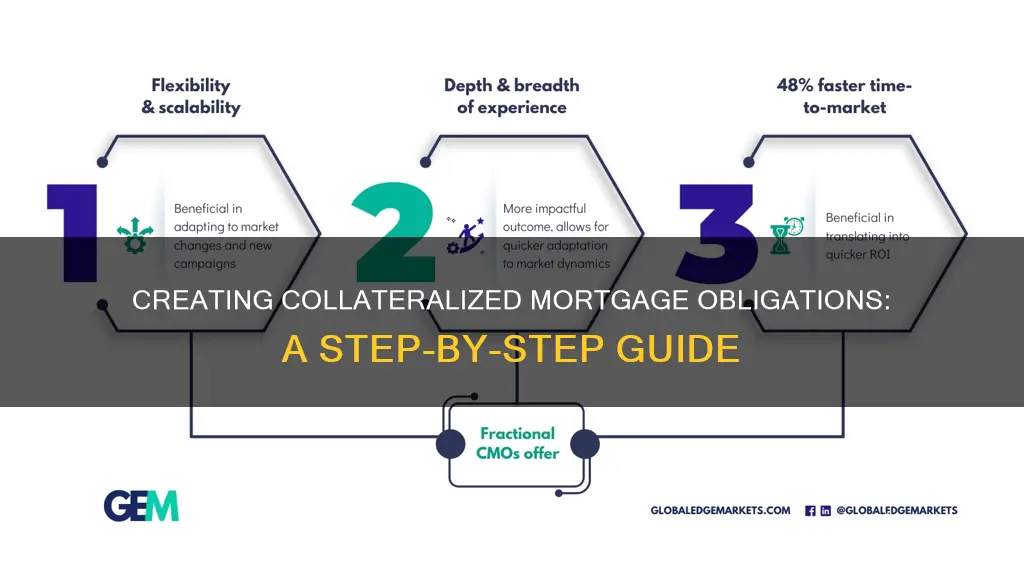
A collateralized mortgage obligation (CMO) is a type of mortgage-backed security that contains a pool of mortgages bundled together and sold as an investment. CMOs are complex debt securities that repackage and direct the payments of principal and interest from a collateral pool to different types and maturities of securities, thereby meeting investor needs. CMOs were first created in 1983 by the investment banks Salomon Brothers and First Boston for the U.S. mortgage liquidity provider Freddie Mac.
| Characteristics | Values |
|---|---|
| Type | Mortgage-backed security |
| Composition | Pool of mortgages |
| Organisation | Maturity and level of risk |
| Cash flow | Cash flows from borrowers' repayments |
| Investors | Hedge funds, banks, insurance companies, pension funds, mutual funds, government agencies, central banks |
| Structure | Tranches or groups of mortgages |
| Sensitivity | Interest rate changes, economic conditions |
| Risk | Credit risk and interest rate risk |
| Issuance | Non-agency mortgage-backed securities |
| Income | Fixed-income security |
What You'll Learn

CMOs are mortgage-backed securities
CMOs, or Collateralized Mortgage Obligations, are a type of mortgage-backed security. They are complex debt securities that repackage and direct the payments of principal and interest from a collateral pool to different types and maturities of securities, meeting investor needs.
CMOs are created by combining or pooling together a group of mortgages, which are then sold as an investment. This is known as securitization. The mortgages are organised by maturity and level of risk, and the CMO receives cash flows as borrowers repay the mortgages, which act as collateral on these securities. The CMO then distributes principal and interest payments to investors based on predetermined rules and agreements.
CMOs are made up of several tranches, or groups of mortgages, organised by their risk profiles. Each tranche will have different principal balances, interest rates, maturity dates, and potential for repayment defaults. The risk is reallocated among the different classes of the CMO, with some classes receiving less risk of a particular type, and others more risk. The way investors are paid differs from traditional mortgage-backed securities, with the structure of the CMO dictating how the income received from collateral will be distributed.
CMOs are issued by non-agency mortgage-backed securities like Fannie Mae, Freddie Mac, or Ginnie Mae. They are sold in a secondary market and not on the stock market. CMOs are fixed-income, meaning investors can expect a certain, steady amount over a set period.
The Cost of Borrowing: $2 on a $400,000 Mortgage
You may want to see also

CMOs are complex debt securities
Collateralized Mortgage Obligations (CMOs) are complex debt securities. They are a type of mortgage-backed security that contains a pool of mortgages bundled together and sold as an investment. CMOs are created by banks and other financial institutions that package or pool together a large number of mortgages, which are then sold as a single investment product. This process is called securitization.
CMOs are complex because they are structured in a way that reallocates risk among different classes of bonds. The mortgages are grouped into classes based on the creditworthiness of the borrowers, and then these classes are further divided into tranches or segments, based on factors such as the mortgage balance, interest rate, and credit risk. Each tranche has a different principal balance, interest rate, maturity date, and potential for repayment defaults. This allows investors to choose a tranche that suits their specific investment goals and risk appetite.
CMOs are also complex because they involve multiple parties and entities. The mortgages are originated by thrifts, mortgage companies, or consumer lending units of commercial banks. These mortgages are then purchased and assembled into pools by a governmental, quasi-governmental, or private entity. This entity becomes the legal owner of the mortgage pool and issues the CMO as a debt security. Investors who want to buy into a CMO purchase bonds from this entity and receive payments from the income generated by the underlying mortgages.
The cash flows from the mortgage pools are directed to different types of securities based on their maturities, and the rules governing these payments are defined by the structure of the CMO. CMOs are sensitive to changes in economic conditions and interest rates, which can affect the performance of the underlying mortgages and the returns generated for investors.
Beating Foreclosure: My Second Mortgage Nightmare
You may want to see also

CMOs are pooled mortgages
Collateralized Mortgage Obligations (CMOs) are pooled mortgages. They are a type of mortgage-backed security, consisting of a pool of mortgages bundled together and sold as an investment. CMOs are complex debt securities that repackage and direct the payments of principal and interest from a collateral pool to different types and maturities of securities.
CMOs are created by combining a group of mortgages with similar characteristics, such as credit score or loan amount, into a single packaged investment called a security. These mortgages are organised by their maturity and level of risk, with the principal repayments and interest payments distributed to investors based on predetermined rules and agreements. The mortgages themselves are referred to as collateral, and the groups of mortgages with similar characteristics are called "classes".
The pool of mortgages is then divided into fractions or slices, called "tranches". Each tranche has a different principal balance, interest rate, maturity date, and potential for repayment defaults. The tranching of the mortgages allows for the reallocation of risk among the different classes. Some classes will have a lower risk of a particular type, while others will have a higher risk. The tranching structure determines how much the risk is reduced or increased for each class.
CMOs are sold to investors, who receive payments from the income generated by the underlying mortgages. The investors in CMOs are typically financial institutions such as hedge funds, banks, insurance companies, pension funds, mutual funds, and government agencies. The potential for profit for these investors depends on whether the mortgage holders repay their mortgages. If the mortgage holders default on their loans, the CMO loses money and cannot pay the investor.
HUD Mortgage Policy: Fueling the Housing Crisis
You may want to see also

CMOs are tranches
Collateralized Mortgage Obligations (CMOs) are complex financial instruments that consist of several tranches or groups of mortgages. These tranches are organised by their risk profiles, with each tranche typically having different principal balances, interest rates, maturity dates and potential for repayment defaults.
Each tranche receives regular interest payments, but the principal payments are made to one tranche at a time until it is retired. This type of CMO is known as a "sequential pay" structure. The first tranche may have a shorter maturity date of 2-3 years, with the second tranche at 5-7 years, and the third at 10-12 years. This allows the issuer to meet different maturity requirements and distribute prepayment variability among tranches.
CMOs may have 50 or more tranches, each with unique characteristics that may be interdependent with other tranches. For example, a CMO with a PO tranche will also have an IO tranche. IO securities are sold at a deep discount and have no face or par value. They increase in value when interest rates rise, so they are often used to hedge portfolios against interest rate risk.
CMOs also contain a "residual" interest tranche, which collects any remaining cash flow after the obligations to the other tranches have been fulfilled. These residuals are not classified as regular interest and may be structured differently, with more complex tax characteristics.
Mortgage Deduction: A Crucial Financial Strategy for Homeowners
You may want to see also

CMOs are sensitive to interest rate changes
Collateralized Mortgage Obligations (CMOs) are complex debt securities that pool together mortgages with similar characteristics, such as credit scores or loan amounts. These mortgage pools are then sold as investment products to investors, who receive payments from the principal and interest repayments made by the individual mortgage borrowers. CMOs are structured into tranches, or segments, which differ in terms of principal balances, interest rates, maturity dates, and potential for repayment defaults.
Secondly, CMOs are often backed by mortgage loans with adjustable or variable interest rates. In a rising interest rate environment, the costs of these mortgages can increase, impacting borrowers' ability to make repayments. This, in turn, can lead to an increased risk of default for the mortgages within the CMO. As a result, investors may experience reduced cash flows and potential losses on their investments.
Additionally, CMOs are sensitive to changes in economic conditions, such as foreclosure rates and the rates at which properties are sold. During economic downturns or periods of financial instability, borrowers may struggle to keep up with their mortgage repayments, leading to higher default rates. This was evident during the 2008 financial crisis, where CMOs played a prominent role and experienced significant losses.
To manage the sensitivity of CMOs to interest rate changes, various strategies can be employed. One approach is credit tranching, where credit losses are absorbed by different classes of bondholders in a sequential manner. By structuring CMOs into senior and junior tranches, the impact of interest rate changes and default risks can be mitigated to some extent.
In conclusion, CMOs are sensitive to interest rate changes due to the underlying structure of the investment product and the variability of interest rates associated with the bundled mortgages. Investors in CMOs need to carefully consider the potential impact of changing interest rates on their investments and the overall economic conditions that may affect borrowers' ability to make repayments.
Mortgages: Understanding the High Cost of $1800 Monthly Payments
You may want to see also
Frequently asked questions
A collateralized mortgage obligation (CMO) is a type of mortgage-backed security that contains a pool of mortgages bundled together and sold as an investment.
CMOs receive cash flows as borrowers repay the mortgages that act as collateral on these securities. CMOs then distribute principal and interest payments to their investors based on predetermined rules and agreements.
CMOs consist of several tranches, or groups of mortgages, organized by their risk profiles. Tranches typically have different principal balances, interest rates, maturity dates, and potential of repayment defaults.







